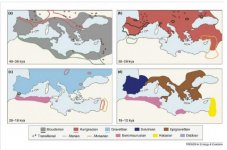Why on gods green earth would the out-of Maghreb hypothesis for western R1b seem almost poetic?
One thing that this whole DNA uncovered was not a huge paradigm shift, but basically that the Archaeologists from before the second world war were not nationalistic hideous proto-fascist liers, a notion widely spread since the sixties, but that they were actually right. Read Greg Cochran on this subject:
https://westhunt.wordpress.com/2014/11/01/the-inexorable-progress-of-science-archaeology/
Especially read what he attributes to Mario Alinei
See my point? The "
racist views that stemmed out of colonialism" have been proven right.
Now I think that in the sixties common sense died and these idiotic ideologically poisoned academics basically
invented a racist motive that wasn't there in the nineteenth century.
You think the racist views used to justify colonialism were correct, were they? You think that's what Cochran is saying in that article? I don't think that's an accurate reading at all. He's just describing the history of what occurred.
The actual history of what happened is that "Scientific Racism"
was used to justify colonialism by Europeans and also to justify slavery. That's an incontrovertible fact. To that extent, if in nothing else, Alinei was correct. It's also a fact that the anthropological studies and archaeology of migrations into Europe were eagerly seized upon and used and misused to justify theories of racial and ethnic superiority.
See:
https://en.wikipedia.org/wiki/Scientific_racism
It's a totally factual account. Anyone can check the references. It got so bad that someone actually wrote the following drivel:
"
“In the United States, scientific racism justified Black African slavery to assuage moral opposition to the Atlantic slave trade. Alexander Thomas and Samuell Sillen described black men as uniquely fitted for bondage, because of their "primitive psychological organization".[83] In 1851, in antebellum Louisiana, the physician Samuel A. Cartwright (1793–1863), considered slave escape attempts as "drapetomania", a treatable mental illness, that "with proper medical advice, strictly followed, this troublesome practice that many Negroes have of running away can be almost entirely prevented".”
Starting in the 20th century those theories, many of them half baked, and the "Indo-European" saga were used by the Germans to justify the subjugation of the rest of Europe (except, in their scheme, their "Nordic" brothers in Scandinavia), going so far as to justify their extermination of the Jews and the plans to do the same to the Slavs.
For my part I do indeed think it's
poetic justice that it turns out that they have a nice healthy dose of EEF derived mostly from the Middle East, and that the approximately half of their ancestry that derives from the Yamnaya people is itself half "Near Eastern", just as it's
poetic justice that Hitler turned out to have yDna "E". I hope they're all rolling in their graves.
It was in revulsion against this history of the use and misuse of these theories that archaeologists operated, not just in the 60's, but starting as early as right after the war. What Cochran is alluding to in those poorly worded sentences at the end of the piece is that this new generation of archaeologists was also influenced by ideology. It's endemic to human endeavors, and therefore it's the rare writer on any topic who even tries, much less succeeds, in removing personal biases from the examination of data. That doesn't mean this shouldn't be the goal in so far as is humanly possible.
This sort of bias driven analysis continues to this day. Just as I don't think it's correct to use poorly understood anthropological differences and pre-historical movements of people to justify not even just discrimination, but the actual enslavement and extermination of other human beings, I am now disgusted by the twisting and manipulation of modern data to hold onto those pernicious and abhorrent concepts. You think it's a fluke that migration flow is just fine for some people if it comes from northern Eurasia, but it's found to be absolutely implausible that the WHG might also have ancestry from the Near East, and that even in the absence of firm data and with the premier research lab in the country proposing it as an alternative? I guess they had to accept the flow from there in the Neolithic, but I guess it's too much to have it infect the WHG upon whom they base their "Europeaness" and whiteness.
Poetic justice again that they were dark skinned. The overall stupidity of some of this given that Europe is a sink for gene flow and that even if the WHG were totally Gravettian derived, which the Wu paper discounts, they too probably originally came from the Near East boggles the mind.


